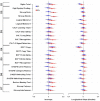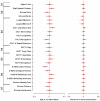Impact of Mild Head Injury on Neuropsychological Performance in Healthy Older Adults: Longitudinal Assessment in the AIBL Cohort
- PMID: 27242516
- PMCID: PMC4863889
- DOI: 10.3389/fnagi.2016.00105
Impact of Mild Head Injury on Neuropsychological Performance in Healthy Older Adults: Longitudinal Assessment in the AIBL Cohort
Abstract
Traumatic brain injury (TBI) is suggested to be a significant risk factor for dementia. However, little research has been conducted into long-term neuropsychological outcomes after head trauma. Participants from the Australian Imaging, Biomarkers and Lifestyle Study of Ageing (AIBL) who had recovered after sustaining a mild TBI involving loss of consciousness more than 5 years previously were compared with matched controls across a 3-year period. Bayesian nested-domain modeling was used to estimate the effect of TBI on neuropsychological performance. There was no evidence for a chronic effect of mild TBI on any neuropsychological domain compared to controls. Within the TBI group, there was some evidence suggesting that the age that the head trauma occurred and the duration of unconsciousness were modulators of episodic memory. However, these findings were not robust. Taken together, these findings indicate that adults who have sustained a TBI resulting in loss of consciousness, but who recover to a healthy level of cognitive functioning, do not experience frank deficits in cognitive ability.
Keywords: Bayesian; ageing; cognition; episodic memory; longitudinal; mild traumatic brain injury.
Figures


Similar articles
-
Longitudinal cognitive decline in the AIBL cohort: The role of APOE ε4 status.Neuropsychologia. 2015 Aug;75:411-9. doi: 10.1016/j.neuropsychologia.2015.06.008. Epub 2015 Jun 20. Neuropsychologia. 2015. PMID: 26102189
-
Subjective and objective cognitive function among older adults with a history of traumatic brain injury: A population-based cohort study.PLoS Med. 2017 Mar 7;14(3):e1002246. doi: 10.1371/journal.pmed.1002246. eCollection 2017 Mar. PLoS Med. 2017. PMID: 28267747 Free PMC article.
-
Neuropsychological Profile of Lifetime Traumatic Brain Injury in Older Veterans.J Int Neuropsychol Soc. 2017 Jan;23(1):56-64. doi: 10.1017/S1355617716000849. Epub 2016 Oct 4. J Int Neuropsychol Soc. 2017. PMID: 27697088 Free PMC article.
-
Cognitive profiles of older adults with a prior traumatic brain injury versus healthy controls: A meta-analysis.Brain Inj. 2018;32(7):832-842. doi: 10.1080/02699052.2018.1463104. Epub 2018 Apr 20. Brain Inj. 2018. PMID: 29676934 Review.
-
[Mild traumatic brain injury and postconcussive syndrome: a re-emergent questioning].Encephale. 2012 Sep;38(4):329-35. doi: 10.1016/j.encep.2011.07.003. Epub 2011 Aug 31. Encephale. 2012. PMID: 22980474 Review. French.
Cited by
-
Dissociation of BDNF Val66Met polymorphism on neurocognitive functioning in military veterans with and without a history of remote mild traumatic brain injury.Clin Neuropsychol. 2020 Aug;34(6):1226-1247. doi: 10.1080/13854046.2020.1740324. Epub 2020 Mar 24. Clin Neuropsychol. 2020. PMID: 32204647 Free PMC article.
-
Interactive Effect of Traumatic Brain Injury and Psychiatric Symptoms on Cognition among Late Middle-Aged Men: Findings from the Vietnam Era Twin Study of Aging.J Neurotrauma. 2019 Jan 15;36(2):338-347. doi: 10.1089/neu.2018.5695. Epub 2018 Sep 4. J Neurotrauma. 2019. PMID: 29978738 Free PMC article.
-
Investigating the relationship between mild traumatic brain injury and Alzheimer's disease and related dementias: a systematic review.J Neurol. 2022 Sep;269(9):4635-4645. doi: 10.1007/s00415-022-11186-9. Epub 2022 Jun 1. J Neurol. 2022. PMID: 35648232
-
Association Between Traumatic Brain Injury and Cognitive Decline Among Middle-to-Older Aged Men in the Vietnam Era Twin Study of Aging.Neurotrauma Rep. 2024 Jun 17;5(1):563-573. doi: 10.1089/neur.2024.0034. eCollection 2024. Neurotrauma Rep. 2024. PMID: 39036434 Free PMC article.
References
LinkOut - more resources
Full Text Sources
Other Literature Sources

